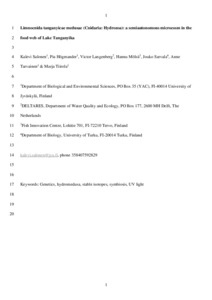Limnocnida tanganyicae medusae (Cnidaria: Hydrozoa): a semiautonomous microcosm in the food web of Lake Tanganyika
Sarvala J; Salonen K; Tarvainen A; Hogmander P; Molsa H; Tiirola M; Langenberg V
Limnocnida tanganyicae medusae (Cnidaria: Hydrozoa): a semiautonomous microcosm in the food web of Lake Tanganyika
Sarvala J
Salonen K
Tarvainen A
Hogmander P
Molsa H
Tiirola M
Langenberg V
SPRINGER
Julkaisun pysyvä osoite on:
https://urn.fi/URN:NBN:fi-fe2021042715312
https://urn.fi/URN:NBN:fi-fe2021042715312
Tiivistelmä
Medusae are important members of marine food webs, but are rare in lakes. In one of the largest lakes in the world, Lake Tanganyika, a small medusa (Limnocnida tanganyicae) is a prominent component of zooplankton. We used field and laboratory methods to study the ecological role of Lake Tanganyika medusae, which occasionally reached high local densities in the whole epilimnion. The largest individuals showed low amplitude, diel vertical migration which minimized their exposure to harmful UV radiation and also may be important for picocyanobacteria regularly present in the medusae. The endosymbiotic picocyanobacteria differed morphologically among medusae and were predominantly one Lake Biwa type Cyanobium sp. that typically was abundant in the water column. Under light, some medusae were net primary producers. Although nitrogen stable isotopic ratios indicated that the free-living cyanobacteria were nitrogen-fixers, the picocyanobacteria in medusae obtained nitrogen predominantly from their host. Stable isotopic ratios of carbon and nitrogen further suggested that copepods were the most likely prey for the medusae. Lake Tanganyika medusae apparently base their metabolism both on animal and plant sources, with possible internal cycling of nutrients; however, the role of picocyanobacteria gardening in the Lake Tanganyika ecosystem and its medusae requires quantification.
Kokoelmat
- Rinnakkaistallenteet [19207]
